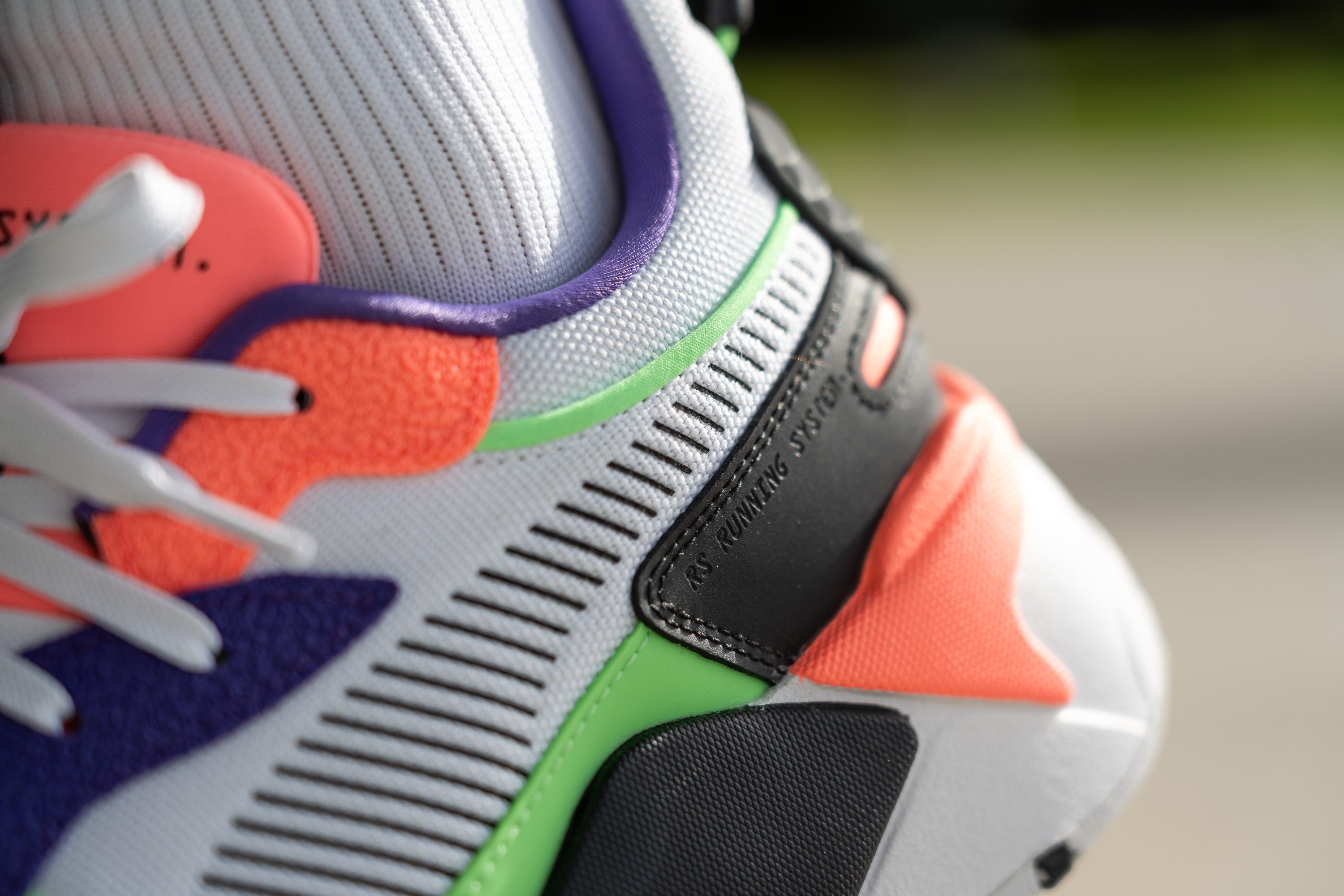Our verdict
- Top pick in best chunky sneakers
- Top pick in best summer sneakers
Pros
- Retro charm
- Numerous vivid colorways
- Very comfortable step-in feel
- Plenty of cushioning for all-day wear
- Breathable, summer-ready upper
- Very stable platform
- Highly durable outsole
- Reasonably priced
Cons
- Heavier than average
- Stiff forefoot
Audience verdict
Comparison
The most similar sneakers compared
+ + Add a shoe | |||||
|---|---|---|---|---|---|
| Audience score | 89 Good! | 95 Superb! | 90 Good! | 93 Great! | |
| Price | $110 | $100 | $120 | $150 | |
| Style | RetroSportyChunky | DadSportyChunky | SportyFuturisticChunky | ClassicSportyFuturisticChunky | |
| Shock absorption | - | - | - | Moderate | |
| Energy return | - | - | - | Moderate | |
| Traction | - | - | - | High | |
| Breathability | Breathable | Breathable | Breathable | Moderate | |
| Weight lab | 16 oz / 455g | 12.2 oz / 347g | 13.2 oz / 373g | 15.1 oz / 427g | |
| Size | True to size | True to size | True to size | True to size | |
| Midsole softness | Soft | Balanced | Balanced | Soft | |
| Material | Mesh | LeatherMesh | Mesh | MeshSuede | |
| Season | SpringFall | Summer | SpringFall | SpringFall | |
| Inspired from | Running | Running | Running | Running | |
| Width / fit | Medium | Medium | Narrow | Medium | |
| Toebox width | Medium | Medium | Narrow | Narrow | |
| Leather/suede quality | - | - | - | Real suede | |
| Toebox durability | Decent | Good | Decent | Decent | |
| Heel padding durability | Bad | Decent | Decent | Decent | |
| Outsole durability | Good | Good | Good | Good | |
| Heel stack lab | 39.9 mm | 35.3 mm | 41.8 mm | 37.3 mm | |
| Stiffness | Stiff | Stiff | Stiff | Moderate | |
| Tongue padding | Average | Average | Average | Average | |
| Drop lab | 17.2 mm | 15.0 mm | 13.5 mm | 11.3 mm | |
| Forefoot | 22.7 mm | 20.3 mm | 28.3 mm | 26.0 mm | |
| Removable insole | ✓ | ✓ | ✓ | ✓ | |
| Heel tab | Finger loop | None | Finger loop | None | |
| Torsional rigidity | Moderate | Moderate | Stiff | Moderate | |
| Heel counter stiffness | Flexible | Moderate | Flexible | Moderate | |
| Sustainable | ✗ | ✓ | ✗ | ✗ | |
| Reflective elements | ✗ | ✗ | ✗ | ✓ | |
| Closure | Laces | Laces | Laces | Laces | |
| Top | Low top | Low top | Low top | Low top | |
| Ranking | #86 Bottom 28% | #5 Top 5% | #75 Bottom 38% | #22 Top 19% | |
| Popularity | #99 Bottom 18% | #103 Bottom 14% | #113 Bottom 6% | #1 Top 1% |
Who should buy
With its hues ranging from straightforward duotone to multicolored splashes, there is an RS-X for every individual. We believe that it's the right PUMA footgear for you if:
- you want a bold, brightly colored retro silhouette
- you need a breathable mesh sneaker for summertime
- you prefer generously cushioned kicks for all-day wear
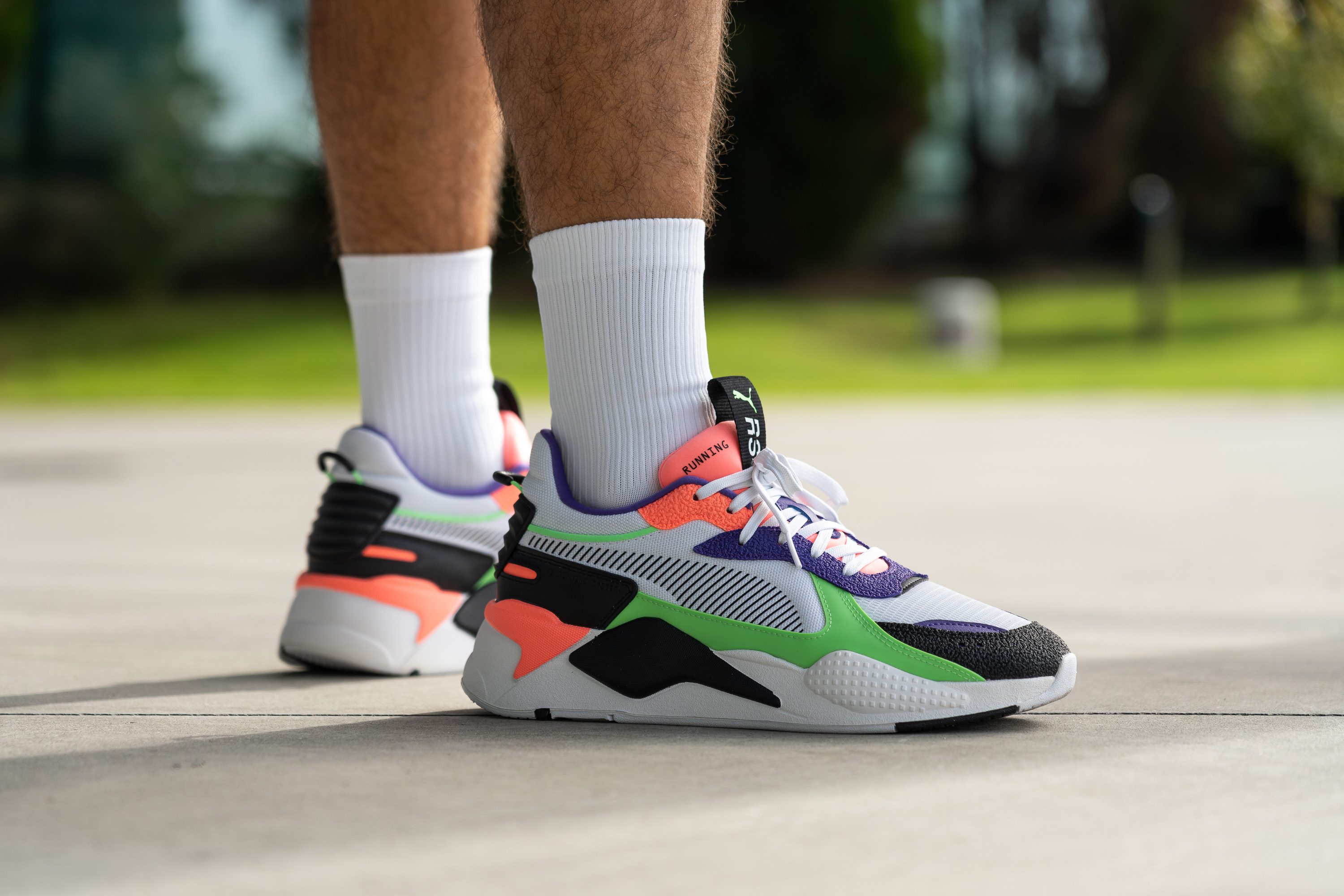
Who should NOT buy
The only major problem with the PUMA RS-X is that it's heavy. Of course, it comes with a heavily cushioned and chunky platform but some people may be willing to give up a few millimeters in return for a lighter sneaker.
If you are okay with a slightly lower sole but notably lighter weight, check out retro silhouettes like the New Balance 530 and the Adidas Ozweego.

Cushioning
Heel stack
Under the heel, this PUMA shoe is an absolute giant!
Based on our caliper measurement, the heel stack (insole and outsole included) of the RS-X is a whopping 39.9 mm thick! It is nearly half an inch taller than average!
We can even say that this PUMA is on the verge of platform sneakers.

| RS-X | 39.9 mm |
| Average | 30.7 mm |
Forefoot stack
As expected, the PUMA RS-X is pretty thick in the forefoot as well.
With our caliper showing 22.7 mm, it is notably taller than the average. Needless to say, we felt pretty high off the ground wearing this PUMA shoe.
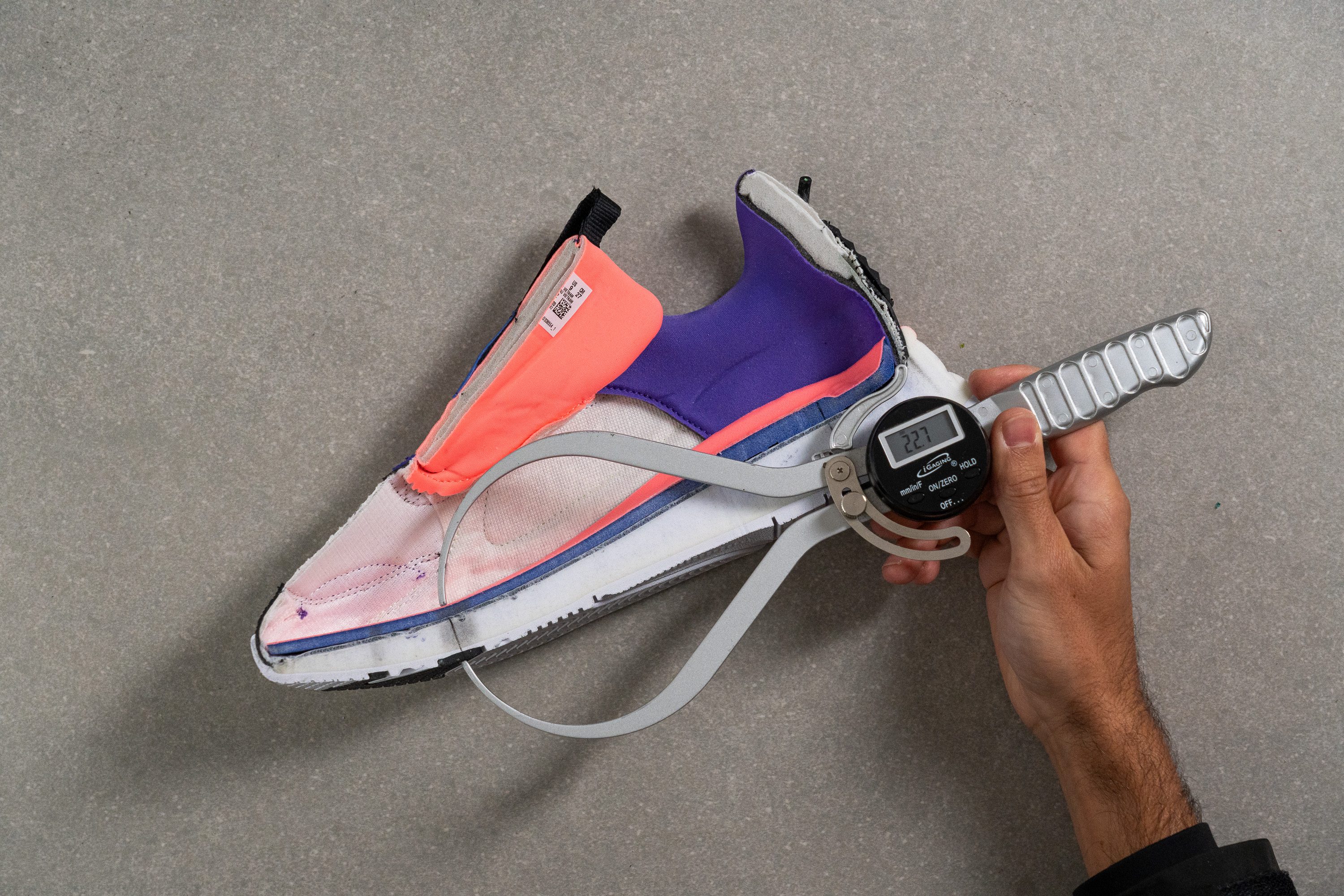
| RS-X | 22.7 mm |
| Average | 19.5 mm |
Drop
If you enjoy the feeling of massive cushioning beneath your heel, the PUMA RS-X should feel right at home.
Given the difference in its stack heights, the RS-X elevates your heel as much as 17.2 mm above the toes. This is one of the highest drops we've ever seen in a sneaker.
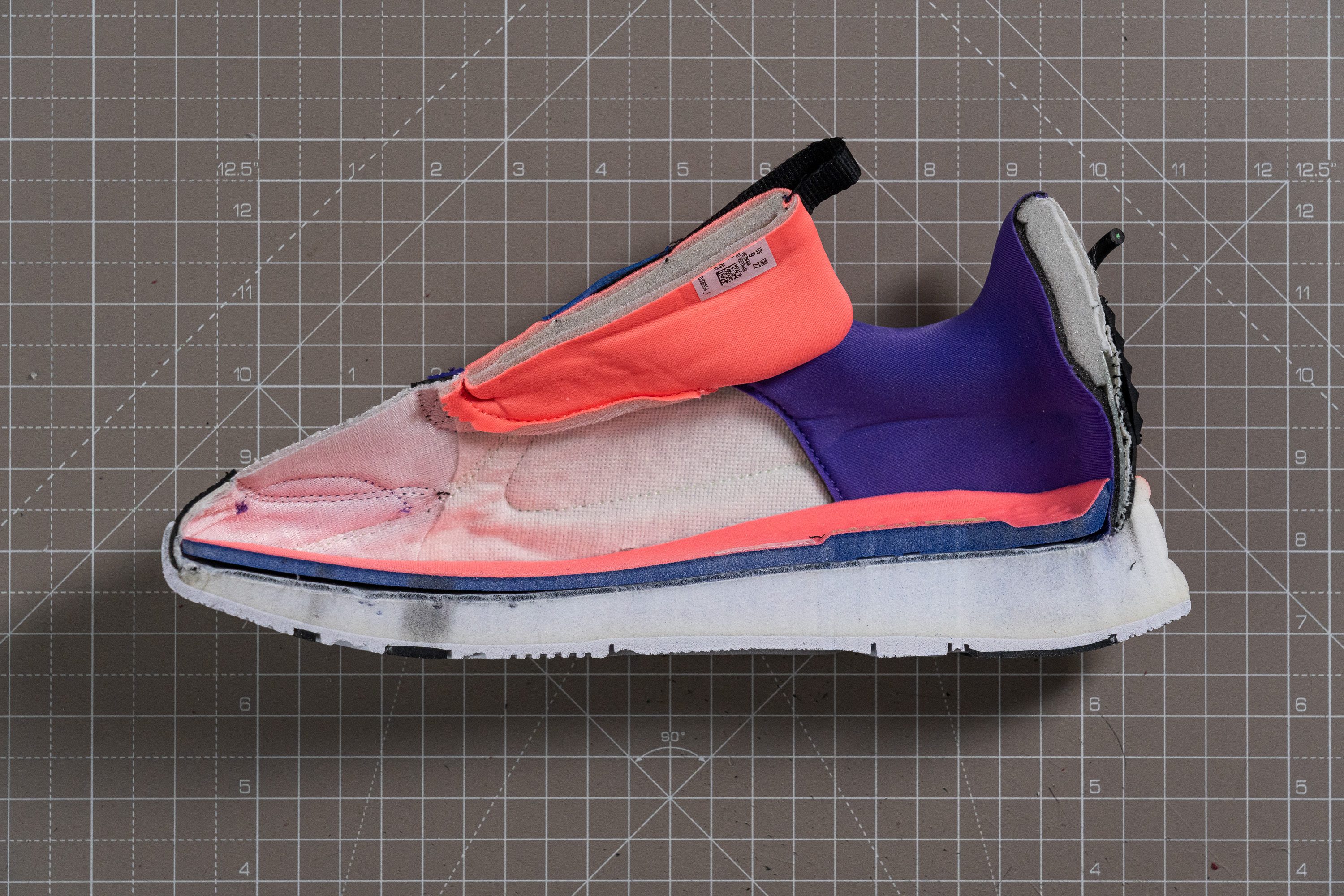
The main benefit of this setup is that your heel receives notably more cushioning, while the ankle doesn't have to do much work. But this is a matter of personal preference, of course, as some people do like more natural-feeling kicks with a lower drop (i.e. Adidas Gazelle at 8.3 mm).
| RS-X | 17.2 mm |
| Average | 11.2 mm |
Midsole softness
From the look of it, the PUMA RS-X appears to be very firm and rigid. Oh how delighted we were to find out that it's not true!
On foot, this sneaker actually felt quite bouncy! Which means there was enough softness to it to compress.
Indeed, our durometer showed that the shoe's foam comes in at 15.6 HA which is 100% softer than sneakers on average!
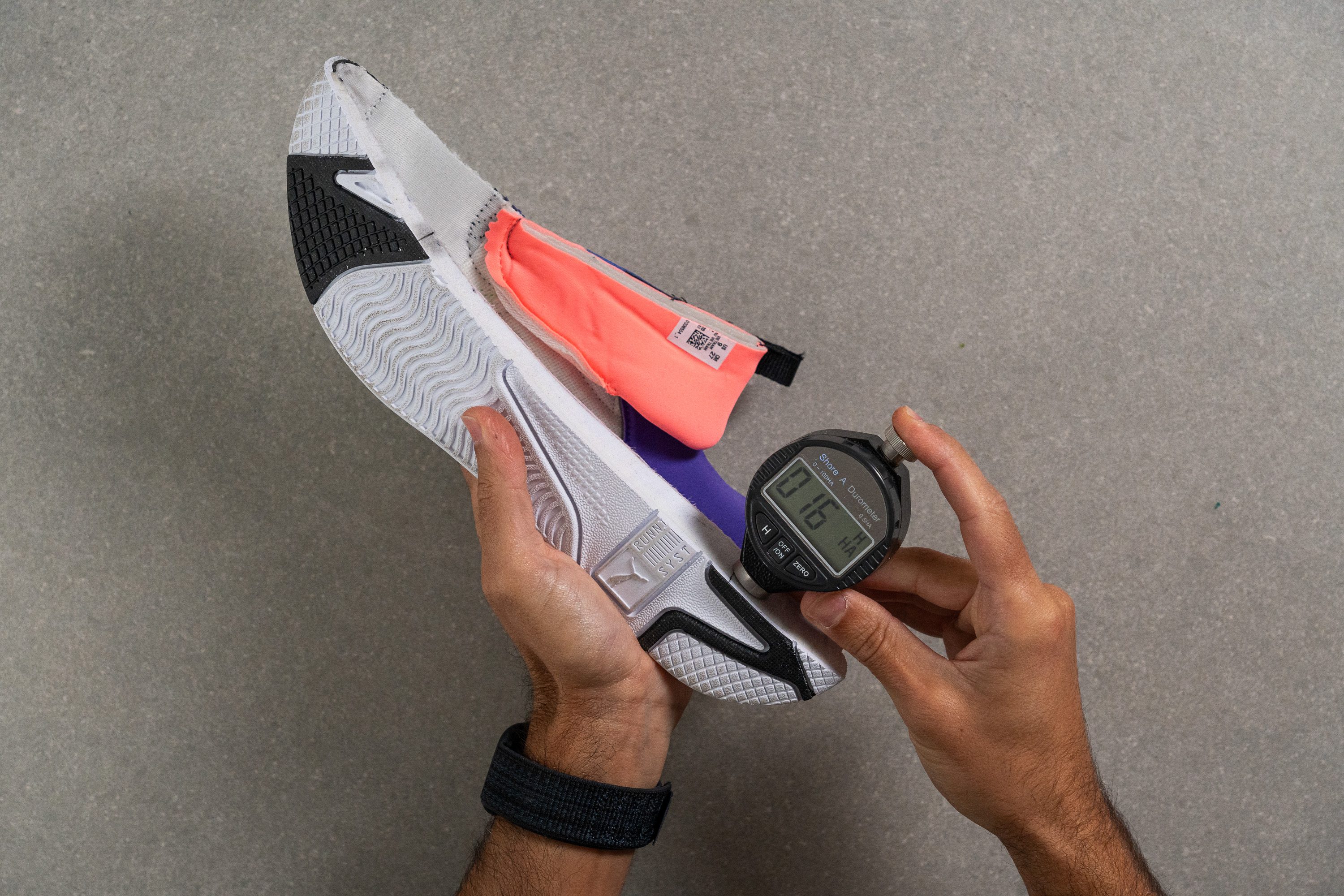
| RS-X | 15.6 HA |
| Average | 28.6 HA |
Size and fit
Size
PUMA RS-X fits true to size (28 votes).
Width / Fit
Our wear tests showed that the PUMA RS-X has a perfect medium-width fit and our lab measurements confirmed it.
Taking a gel mold out of the shoe, we measured its widest area at 92.2 mm. Exactly the same as the average of D medium sneakers.
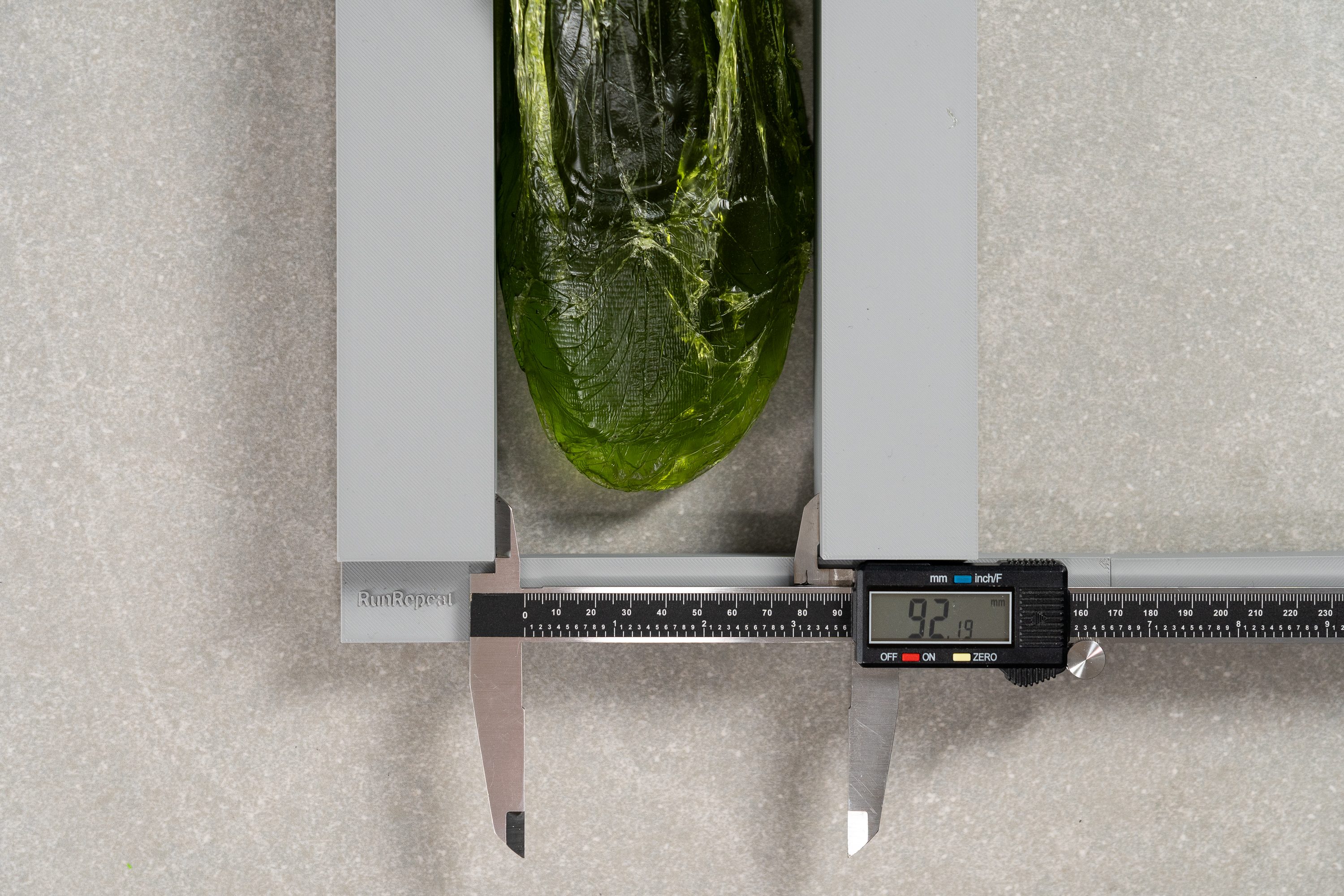
| RS-X | 92.2 mm |
| Average | 92.5 mm |
Toebox width
The taper angle is also very mild in the shoe's toebox. Putting a caliper at the big toe mark returned a slightly wider than average reading of 69.6 mm.
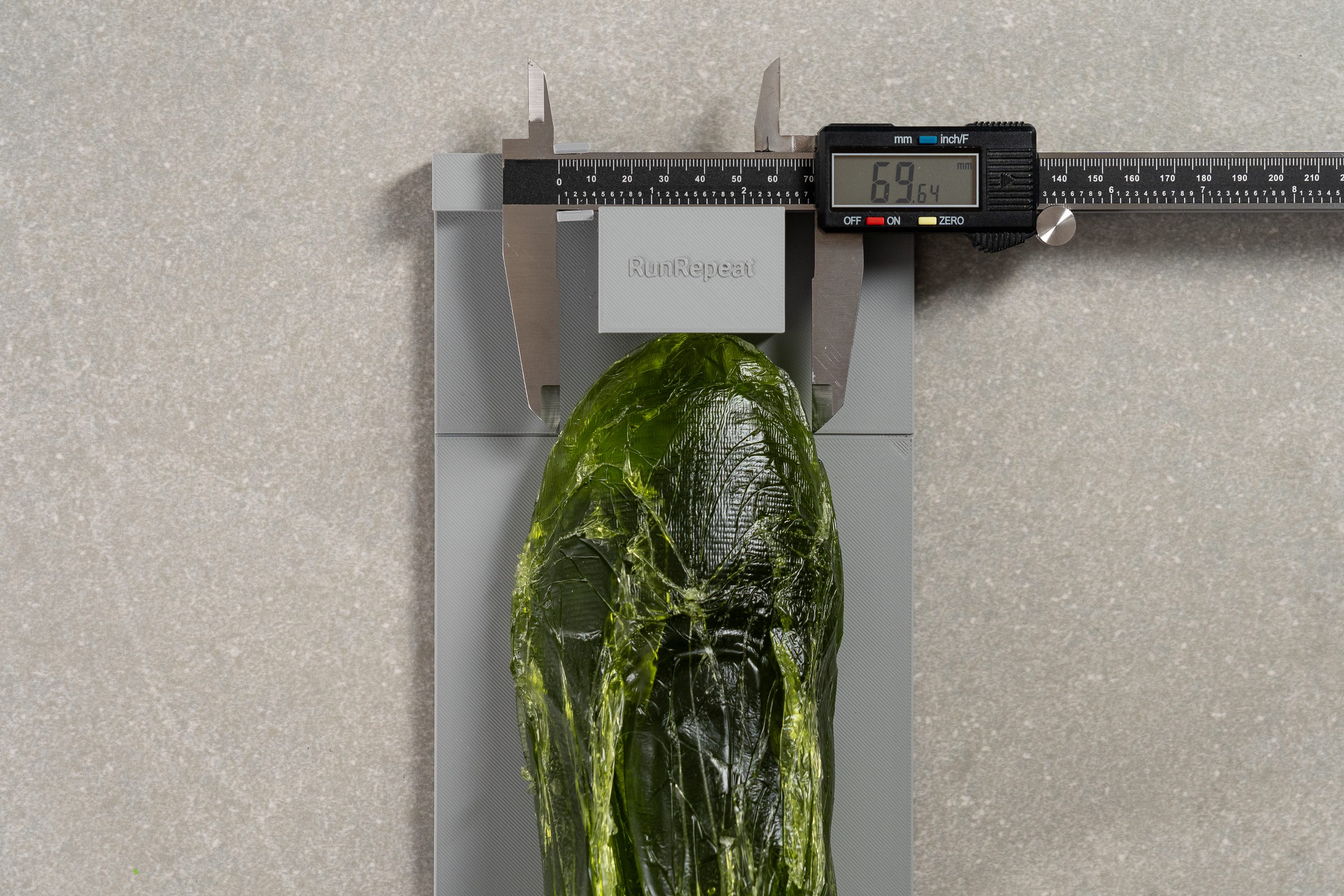
| RS-X | 69.6 mm |
| Average | 68.9 mm |
Toebox height
A standard toebox height of 27.3 mm concluded the shoe's medium fit.
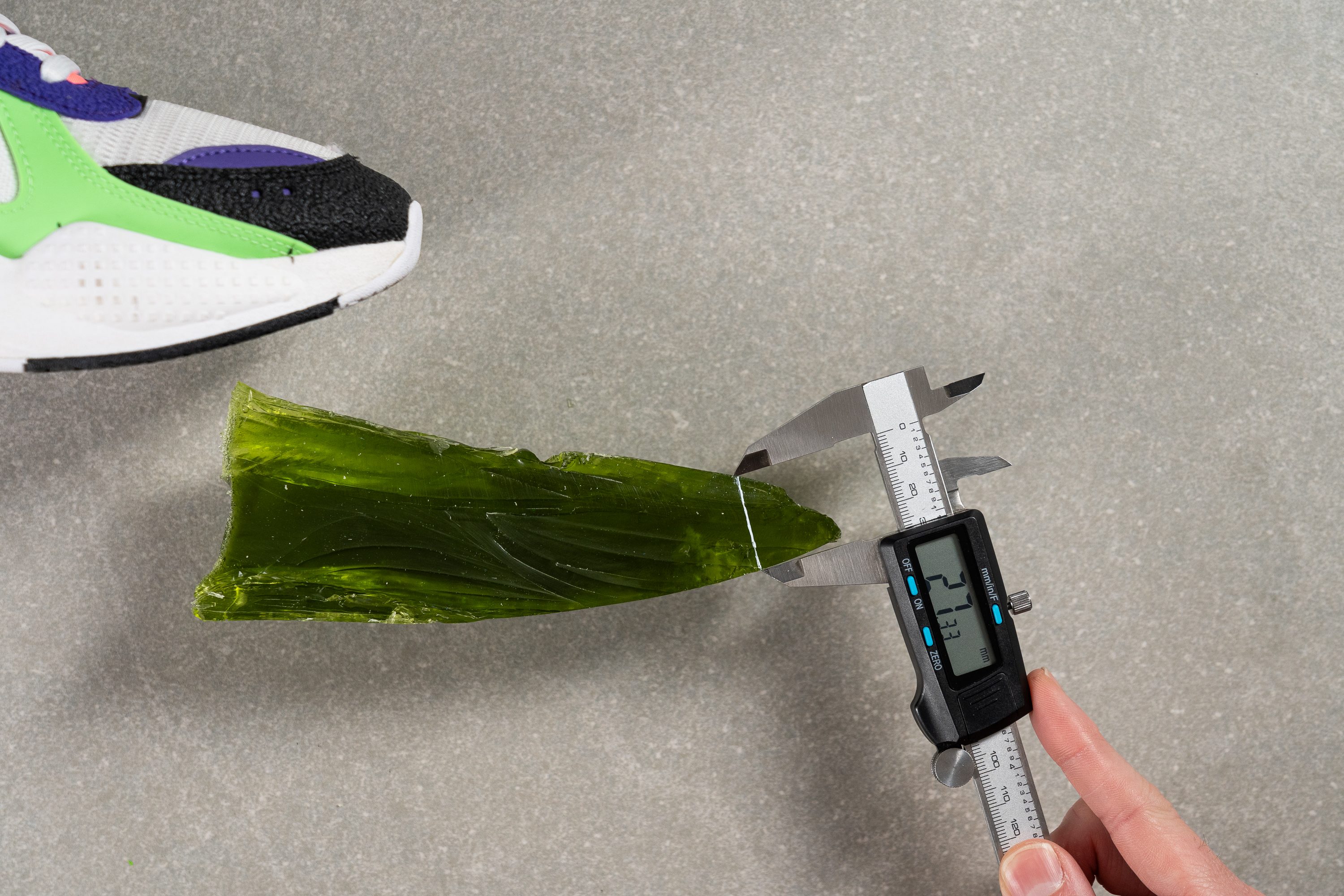
| RS-X | 27.3 mm |
| Average | 27.8 mm |
Flexibility / Stiffness
Of course, we couldn't expect the PUMA RS-X to bend like an acrobat given how much is going on in its base.
Using a force gauge, we measured that it took 26.5N to bend this PUMA sneaker to a 90-degree angle. That is 40% more than it takes an average sneaker.
This test follows an older methodology, which is why you don't see recently tested shoes in the chart. Results from different methodologies can not be compared.
| RS-X | 26.5N |
| Average | 23.3N |
Weight
The PUMA RS-X is a hefty one, no doubt about that.
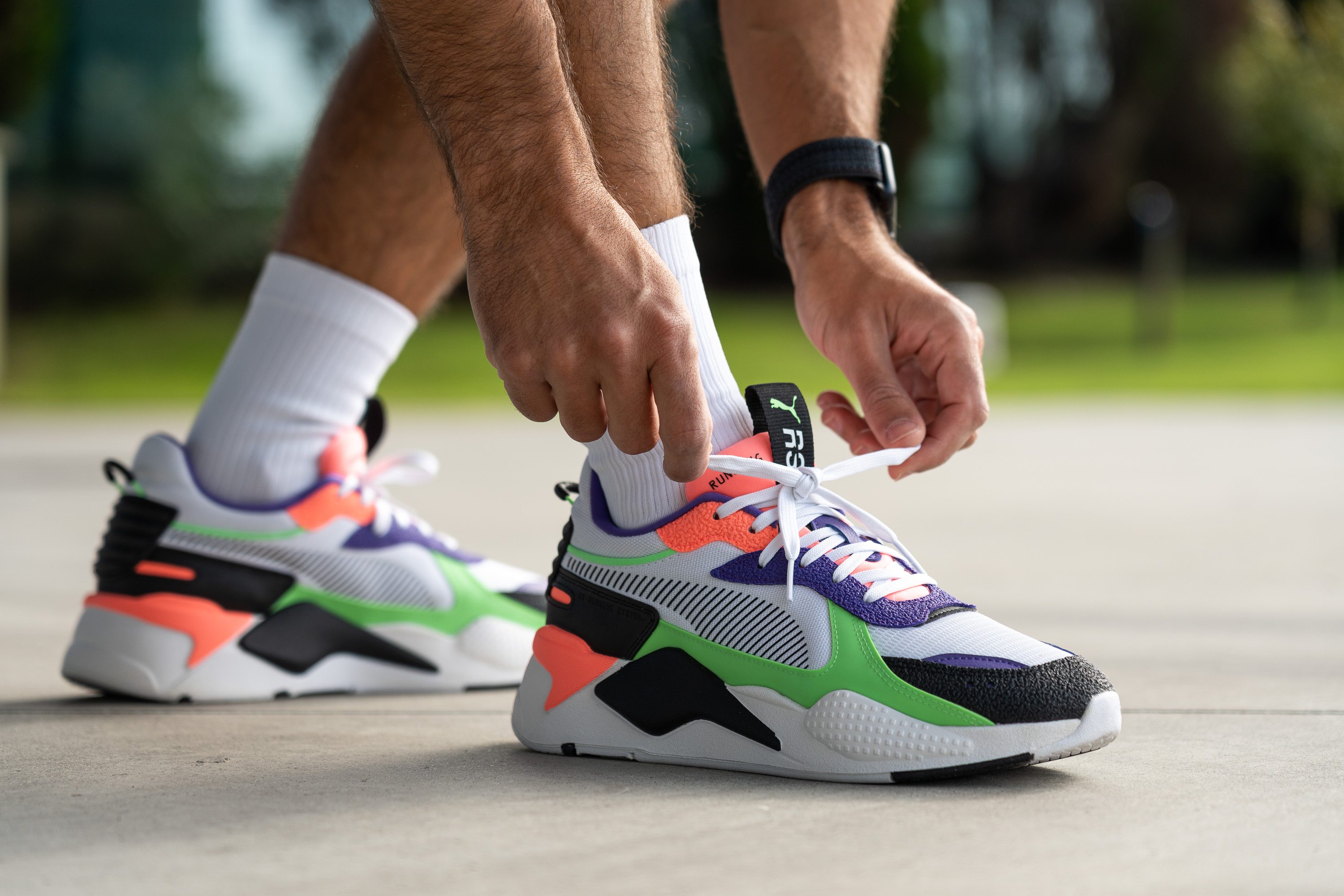
Putting it on our scale, we got 16 oz (455g) in a men's US size 9. This is more than 2 ounces heavier than sneakers on average.
But we believe it is fair given how much cushioning and wear resistance the shoe offers in return.
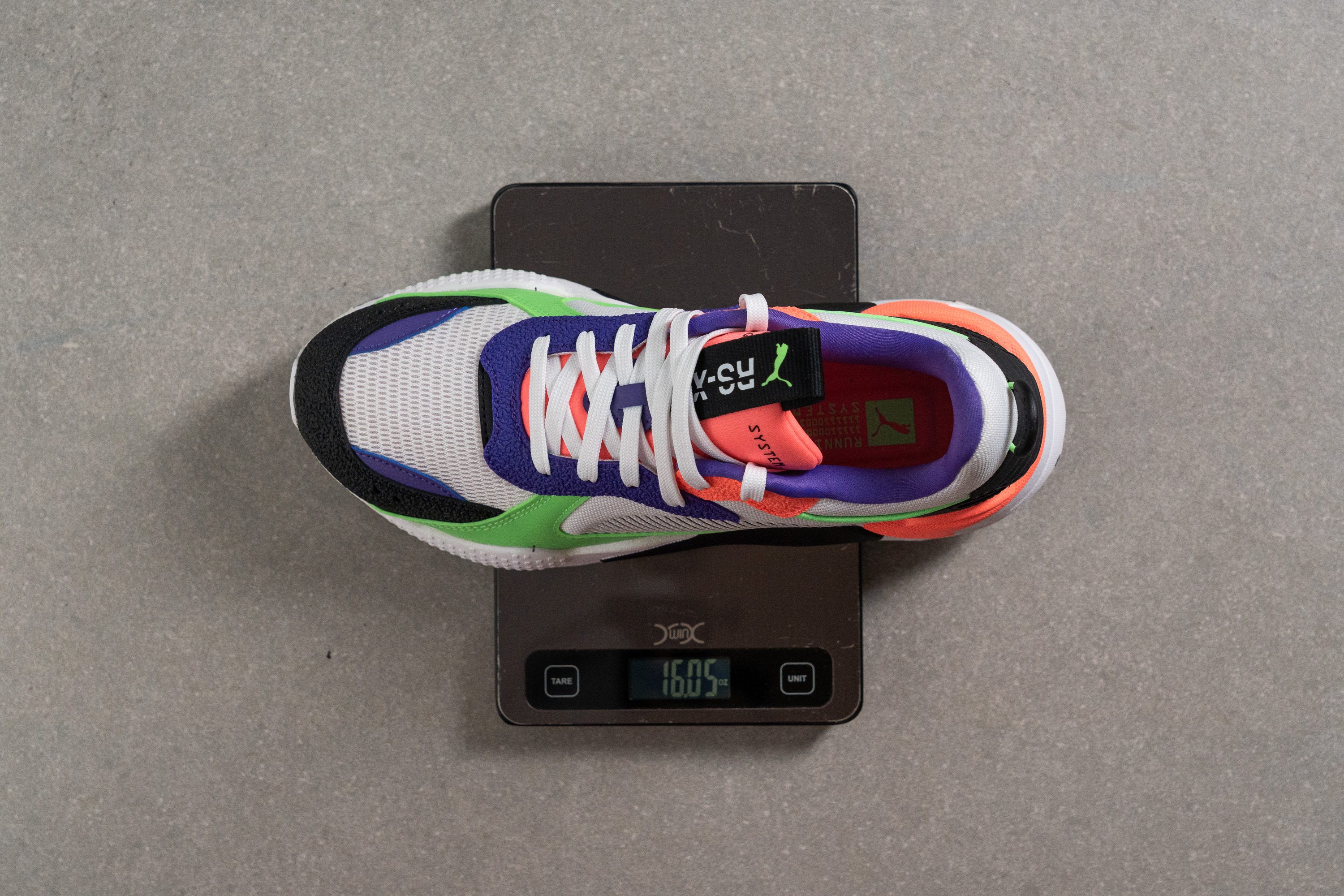
| RS-X | 16.0 oz (455g) |
| Average | 13.8 oz (390g) |
Breathability
If you believe that a chunky sneaker cannot be breathable, the RS-X is here to prove that wrong.
Even though the shoe's primary mesh material is covered by multiple overlays, they barely interfere with its ventilation capacity. Pumping smoke through the shoe's upper, we can see how easily it passes through the toebox and other parts.
On a 1-5 scale, where 5 is the most breathable, we can readily give the PUMA RS-X a 4.
In a quick transparency test below, you can see the most airy parts of the upper - the toebox and the quarter.
Using a microscope, we also took a closer look at the mesh itself. As you can see, it is quite porous, allowing lots of air in and out.
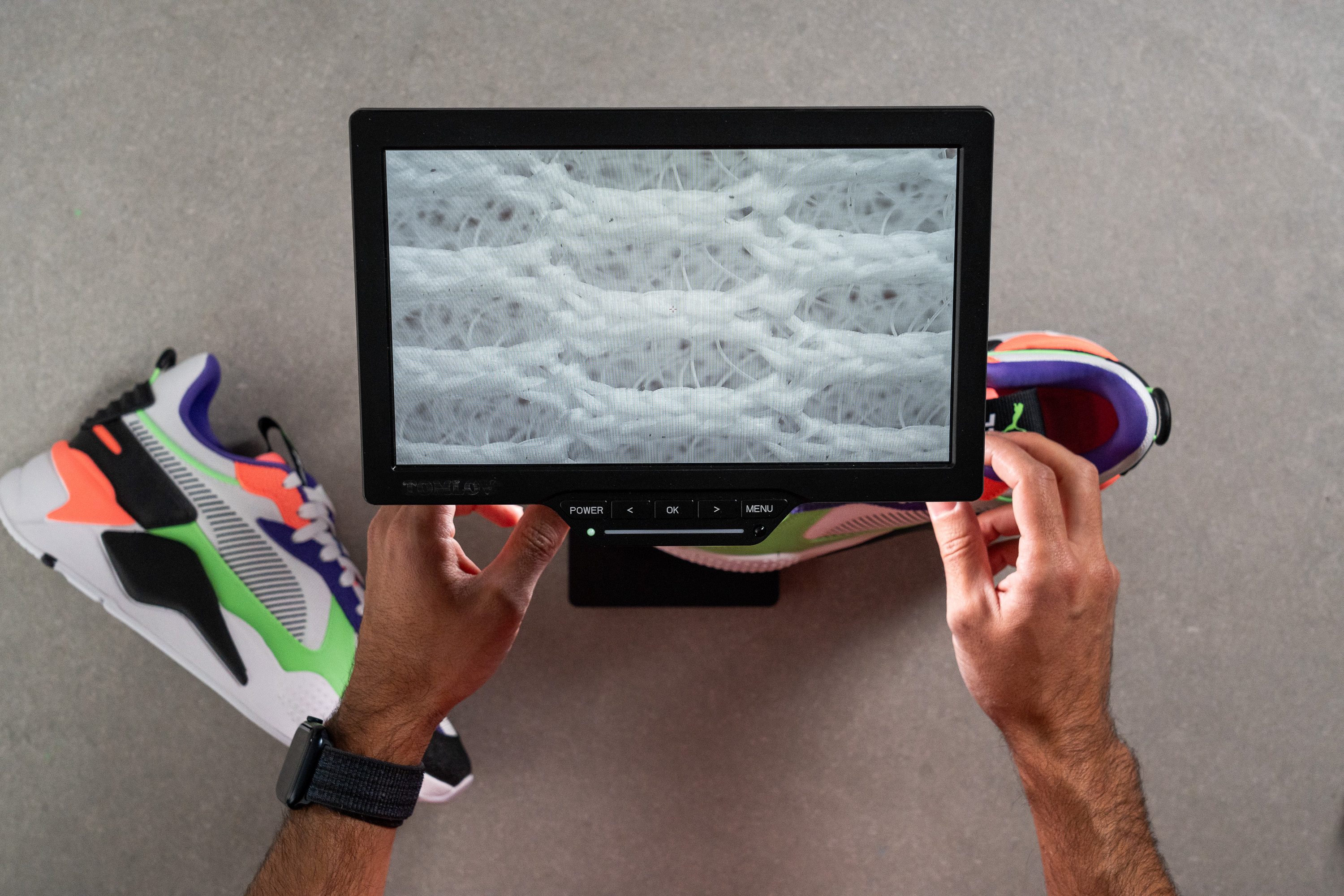
The nature of this primary mesh fabric is also amazingly lightweight and pliable.
| RS-X | 4 |
| Average | 3 |
Stability
Lateral stability test
If you are worried about feeling unstable wearing such a high platform, don't be!
PUMA took care of this by adding enough torsional rigidity and width to the platform. Never once did we feel concerned about rolling our ankles in the RS-X.
Torsional rigidity
Twisting the PUMA RS-X sideways wasn't so easy! On a 1-5 scale, where 5 is the stiffest, we would rate this sneaker as 4. That is stiffer than the average of casual sneakers.
We really appreciated the way PUMA managed to fuse soft cushioning with side-to-side stiffness in the RS-X.
| RS-X | 4 |
| Average | 3.6 |
Heel counter stiffness
Featuring a whole lot of overlays, we were surprised that the shoe's heel counter remained quite pliable.
With 5 being the stiffest, we rated the RS-X's heel counter stiffness as only 2. It is more flexible than average.
But we didn't feel like the ankle hold was negatively affected by that. Nor did we experience any heel slippage in this PUMA shoe.
| RS-X | 2 |
| Average | 3.2 |
Midsole width - forefoot
Last but not least, the shoe's wide platform is a major contributing factor to its stability.
Even before measuring the RS-X, we could see that it was among the widest platforms we've ever gotten our hands on.
In the widest part of the forefoot, our caliper showed 116.1 mm which is significantly wider than average.
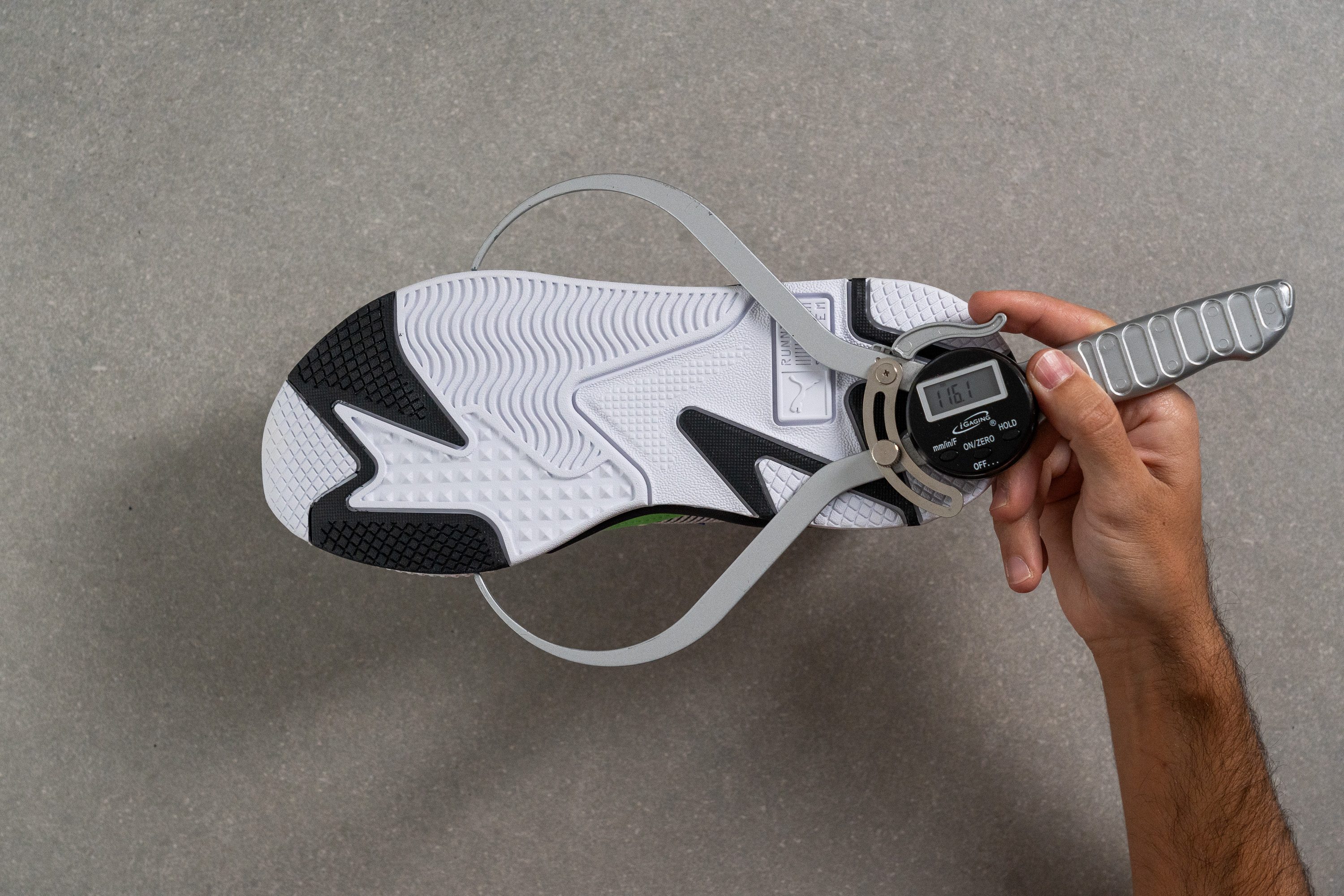
| RS-X | 116.1 mm |
| Average | 108.9 mm |
Midsole width - heel
It gets even crazier in the heel!
With the widest part of the sole showing 94.7 mm, the RS-X is only second to the Adidas Ozweego (98.9 mm)!
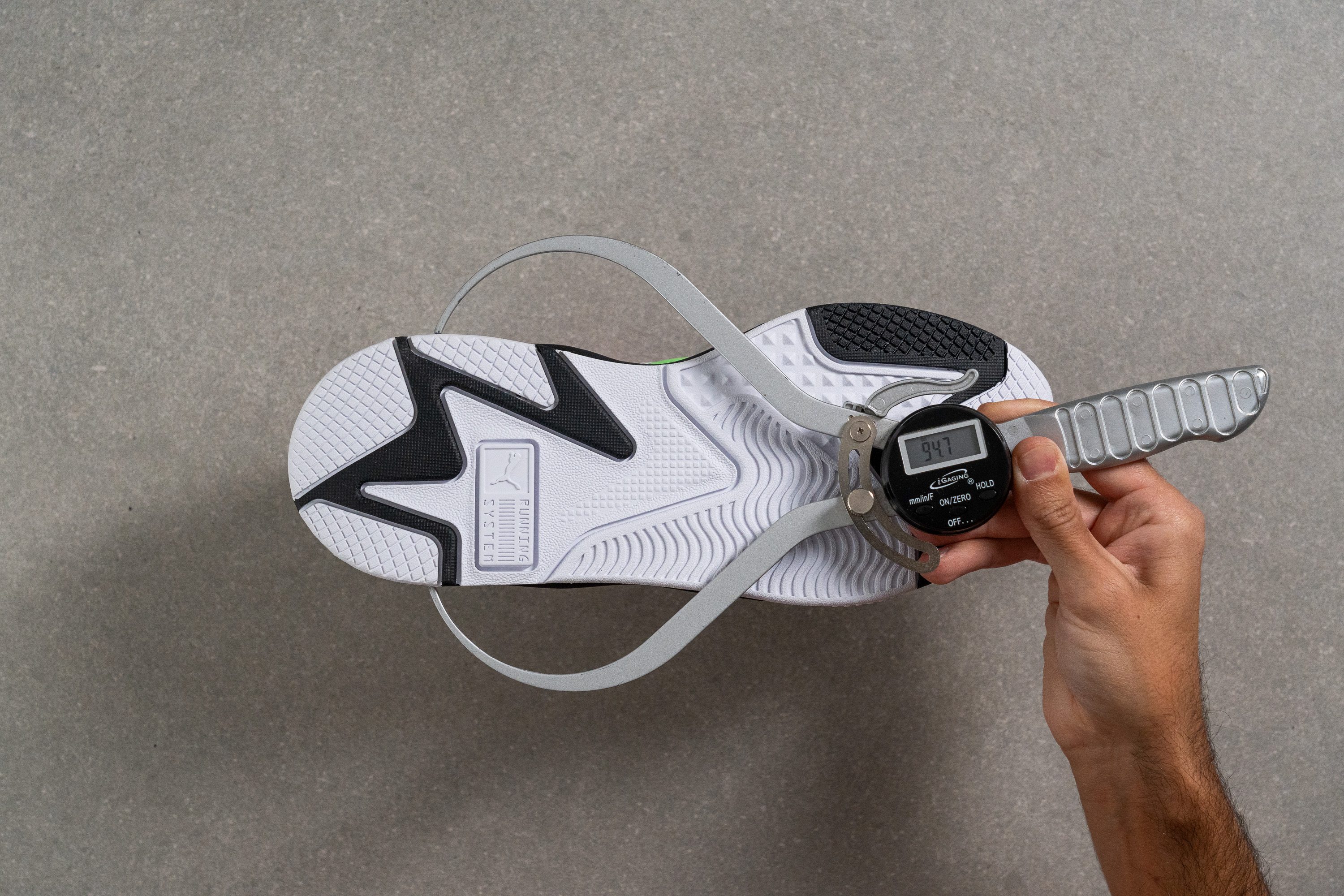
| RS-X | 94.7 mm |
| Average | 84.0 mm |
Durability
Toebox durability
Adding a protective overlay around delicate mesh was a good idea to prolong the shoe's shelf life.
Equipped with a Dremel, we tested out how the toebox holds up against wear and tear. Applying a consistent speed (10K RPM) and force (3.2N), we were pleasantly surprised with the resistance of that synthetic overlay. It definitely saved the mesh from being completely torn apart.
This allows us to rate the toebox's durability with a decent score of 3 out of 5.
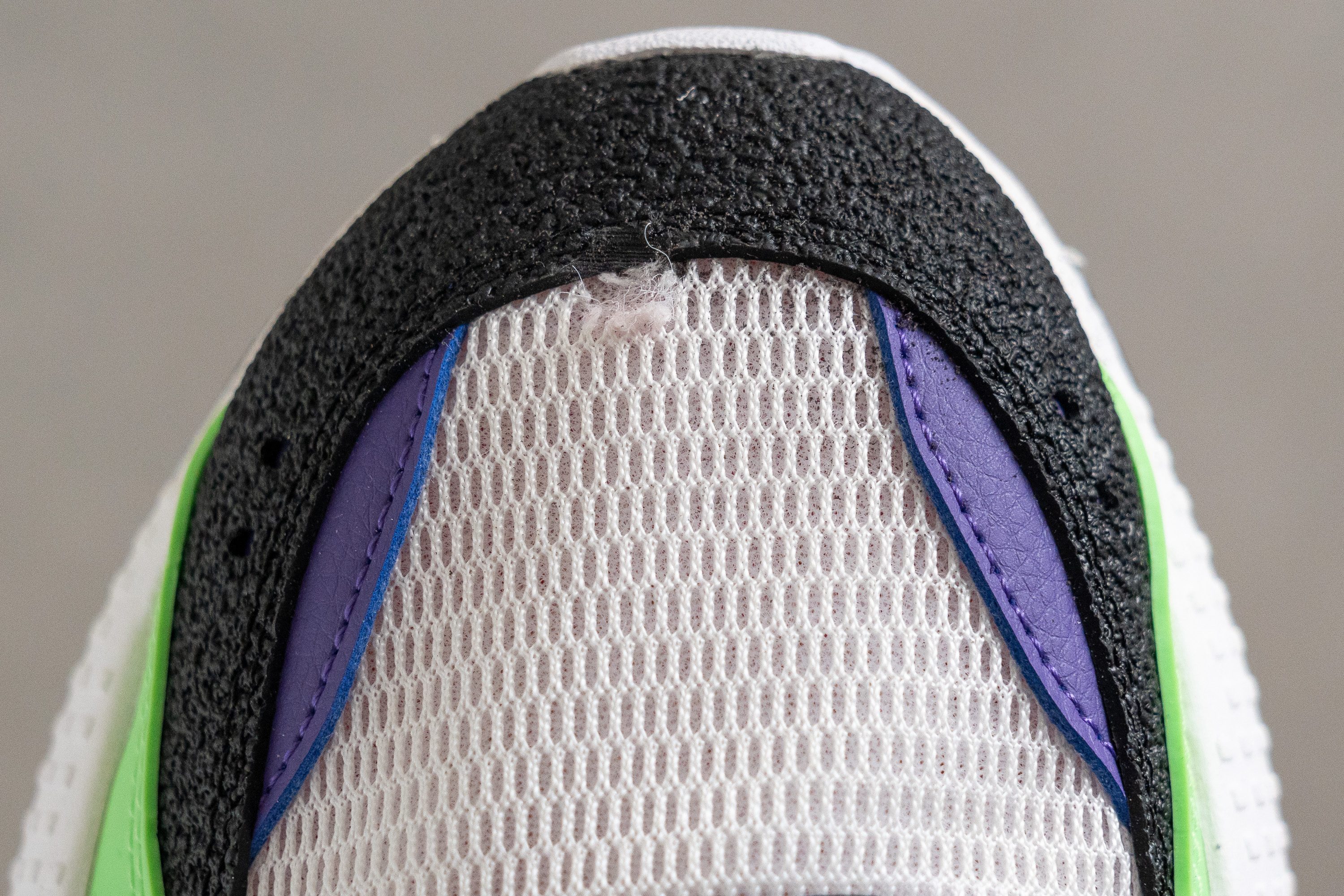
| RS-X | 3 |
| Average | 3.7 |
Heel padding durability
The shoe's interior collar lining is much more exposed in that regard. Made of soft textile, it wasn't able to resist the Dreme so well.
Having applied the tool for only 4 seconds at a moderate speed (5K RPM), the damage was tangible enough to lower its durability rating to 2/5.
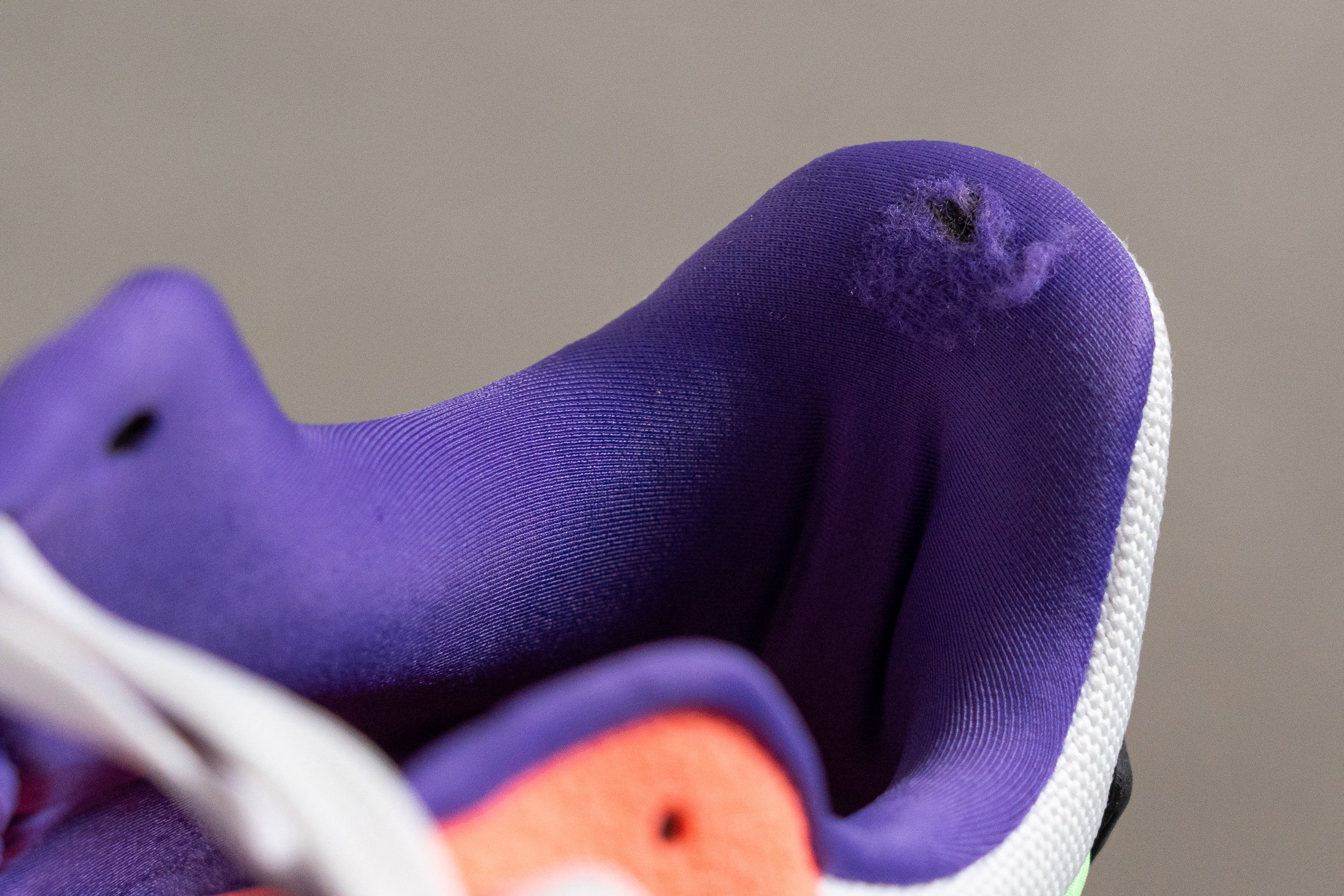
| RS-X | 2 |
| Average | 3.2 |
Outsole hardness
Looks like we're dealing with a pretty sturdy outsole here on the PUMA RS-X.
Using our durometer to check the firmness of the rubber on the RS-X, we got a reading of 86.8 HC. This is harder than average and leads us to expect a little more from the outsole durability.
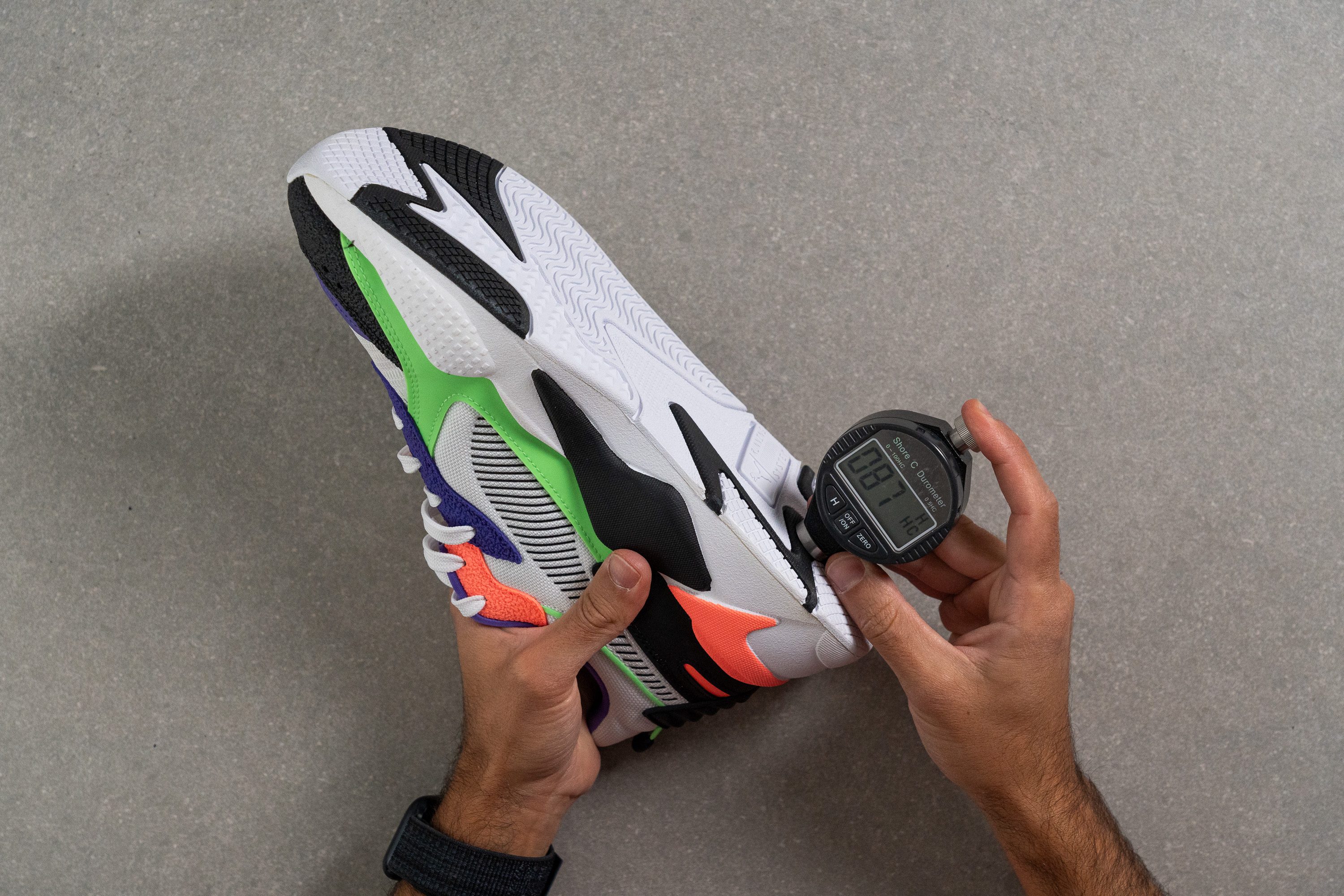
| RS-X | 86.8 HC |
| Average | 85.7 HC |
Outsole durability
And this PUMA sneaker didn't disappoint. Surviving the long 22 seconds of Dremel drilling at a high speed of 10K RPM, the amount of outsole damage was smaller than average!
We measured the depth of the dent with the help of a tread gauge. At 0.8 mm, the RS-X makes it into the more durable range of sneakers.
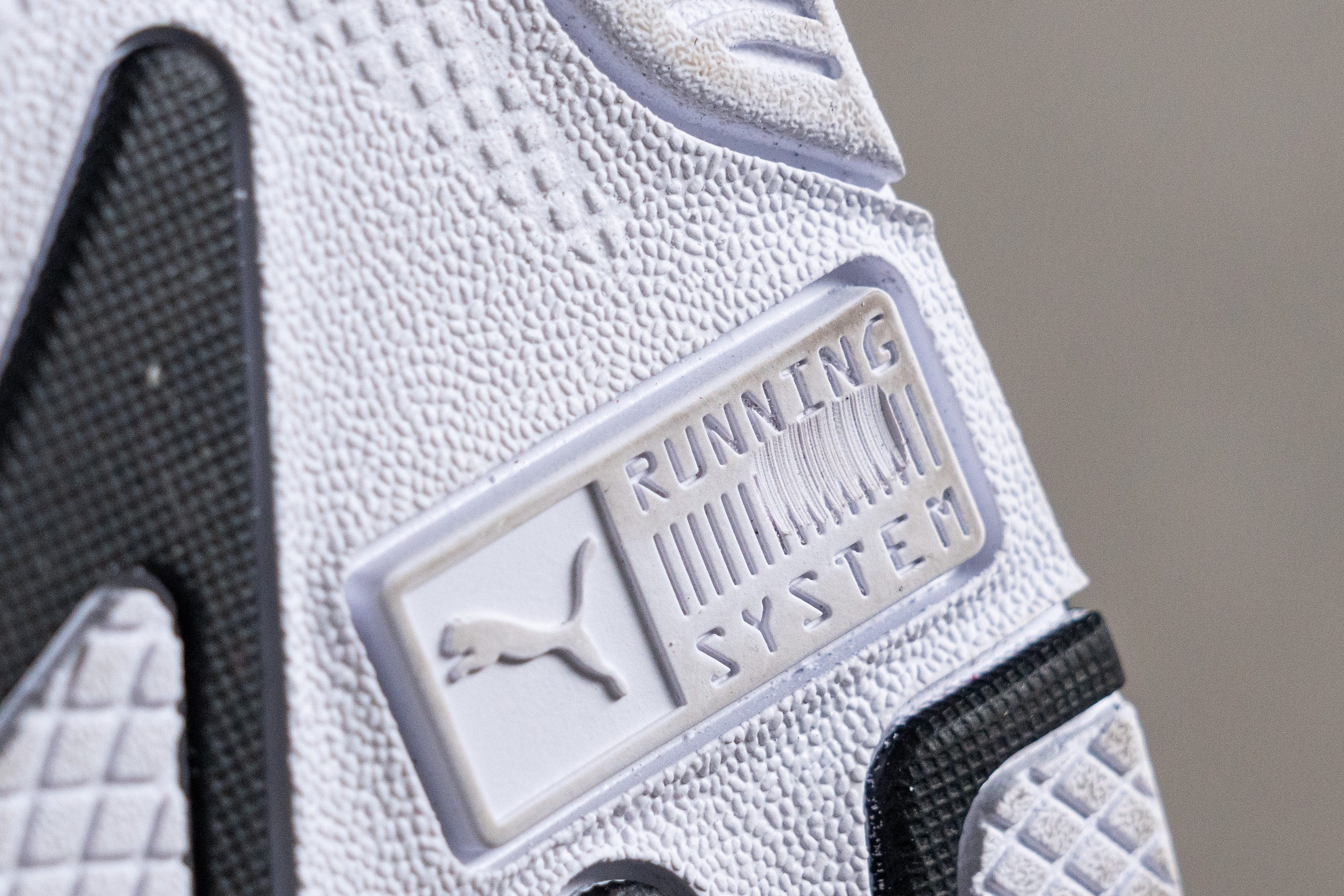
| RS-X | 0.8 mm |
| Average | 1.1 mm |
Outsole thickness
And if you still have any doubts, let us dispel them by saying that the RS-X has one of the thickest outsoles among sneakers!
Using a caliper, we measured the rubber layer at 6.5 mm. It is thicker than in most low-top sneakers. Considering its hardness too, this outsole can take a lot of beating up.
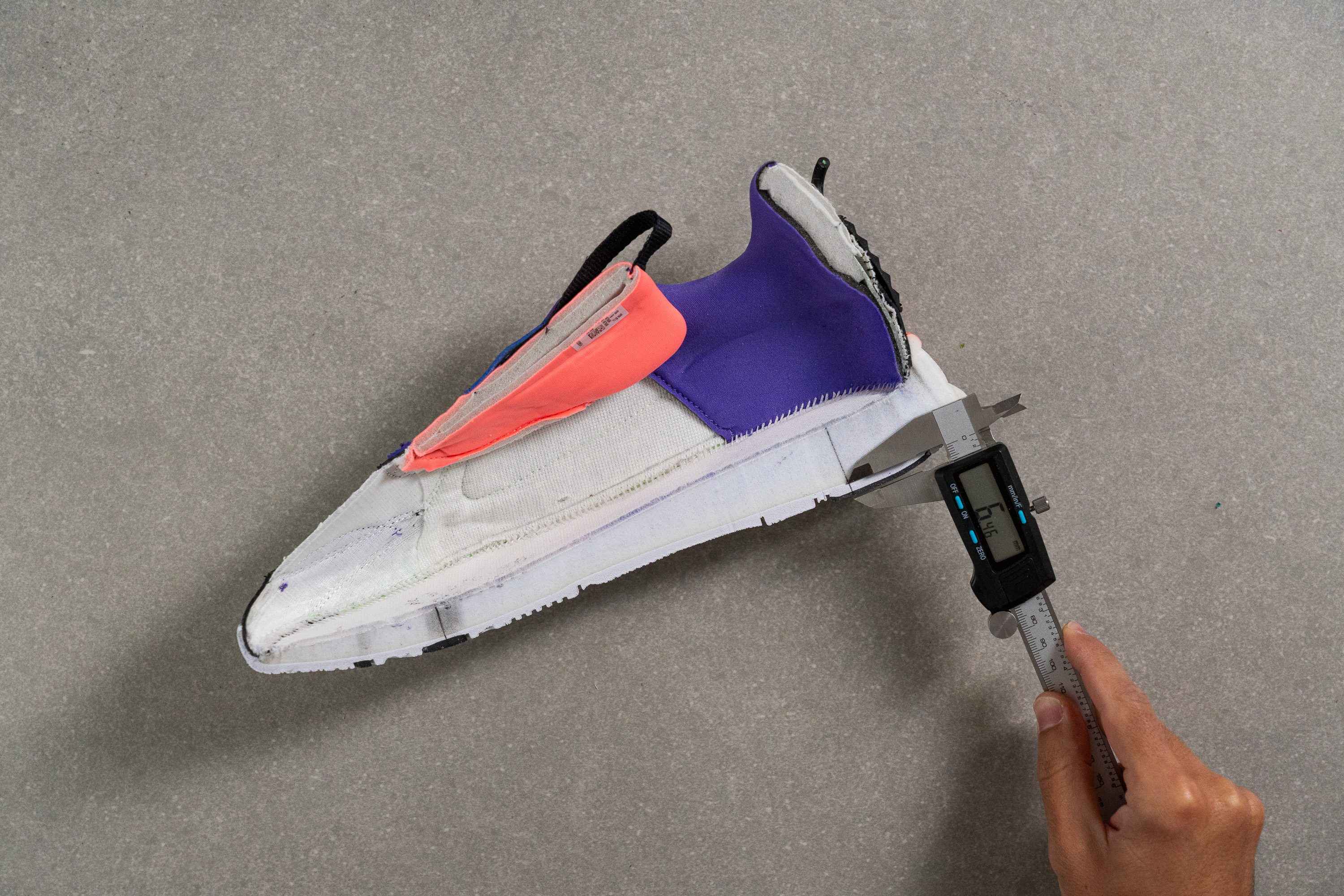
| RS-X | 6.5 mm |
| Average | 5.3 mm |
Misc
Insole thickness
PUMA decided to turn the cushioning volume to the max by inserting an 8-mm insole! Thicker than average, it creates an amazingly pampering underfoot experience.
It's not every day that we see orthotic elements in a stock insole! Bravo, PUMA!
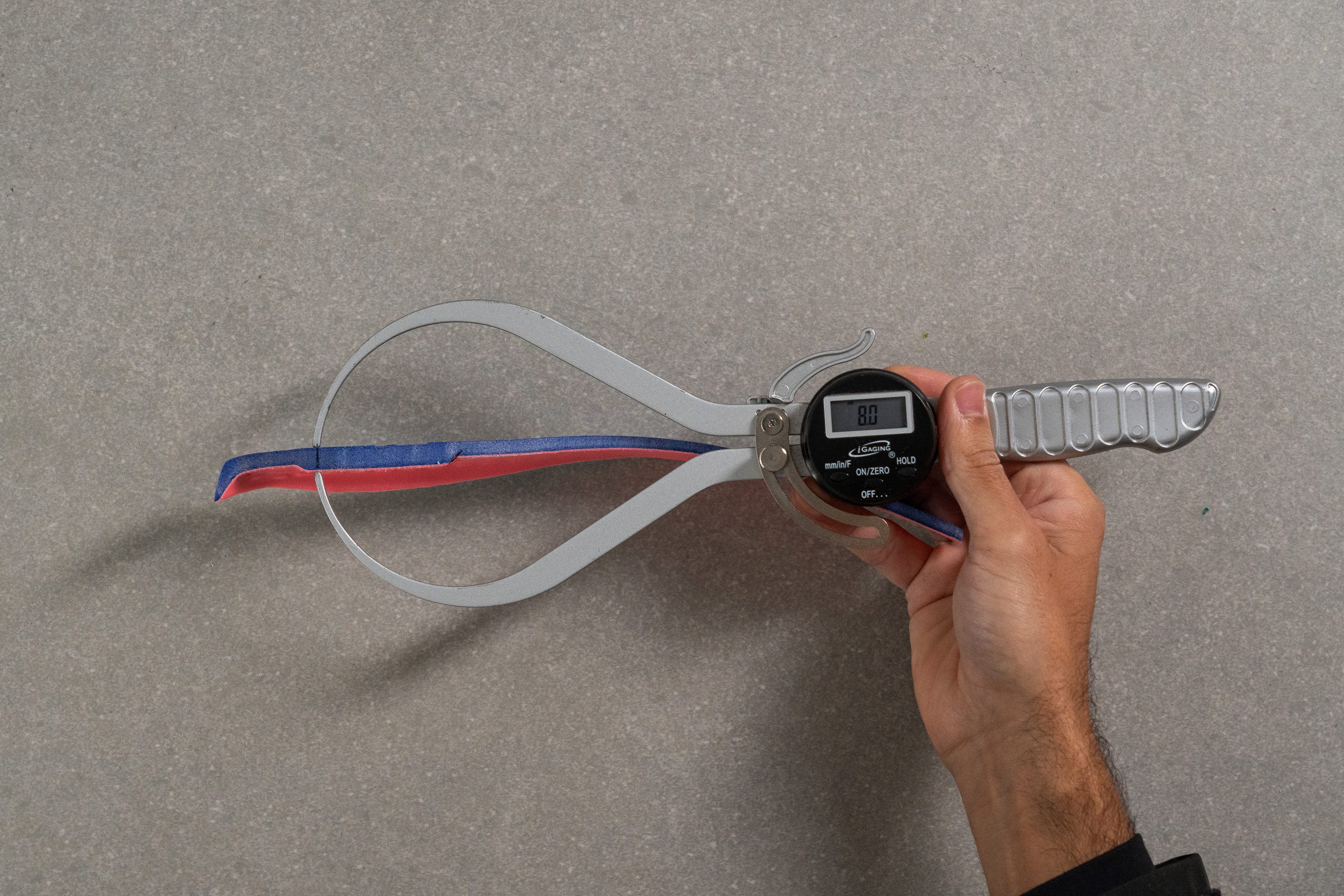
| RS-X | 8.0 mm |
| Average | 5.1 mm |
Removable insole
The shoe's default insole is removable. But given its comfort and arch support, we don't even think there is a need for that!
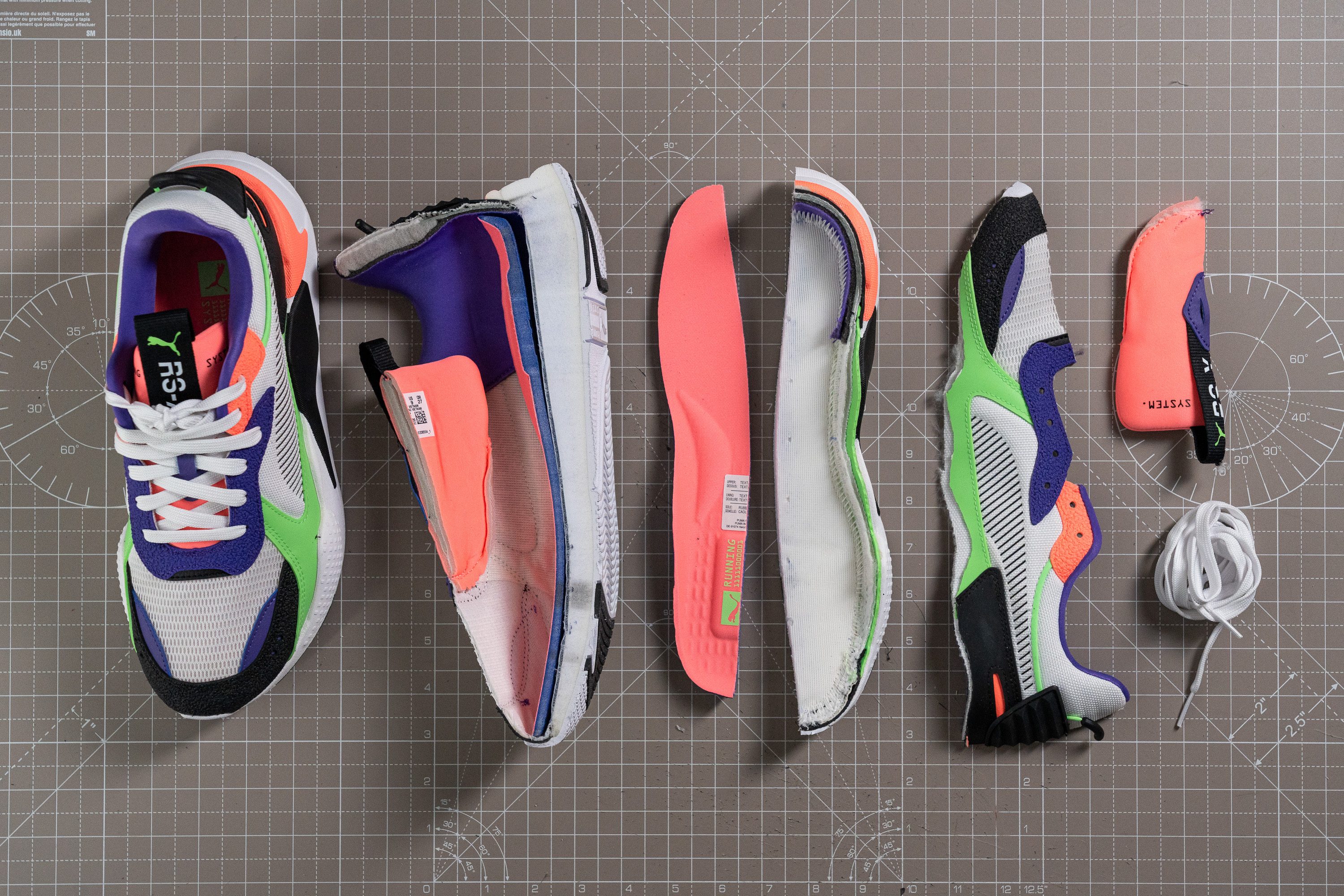
| RS-X | Yes |
Reflective elements
None of the RS-X's elements are reflective in the dark.
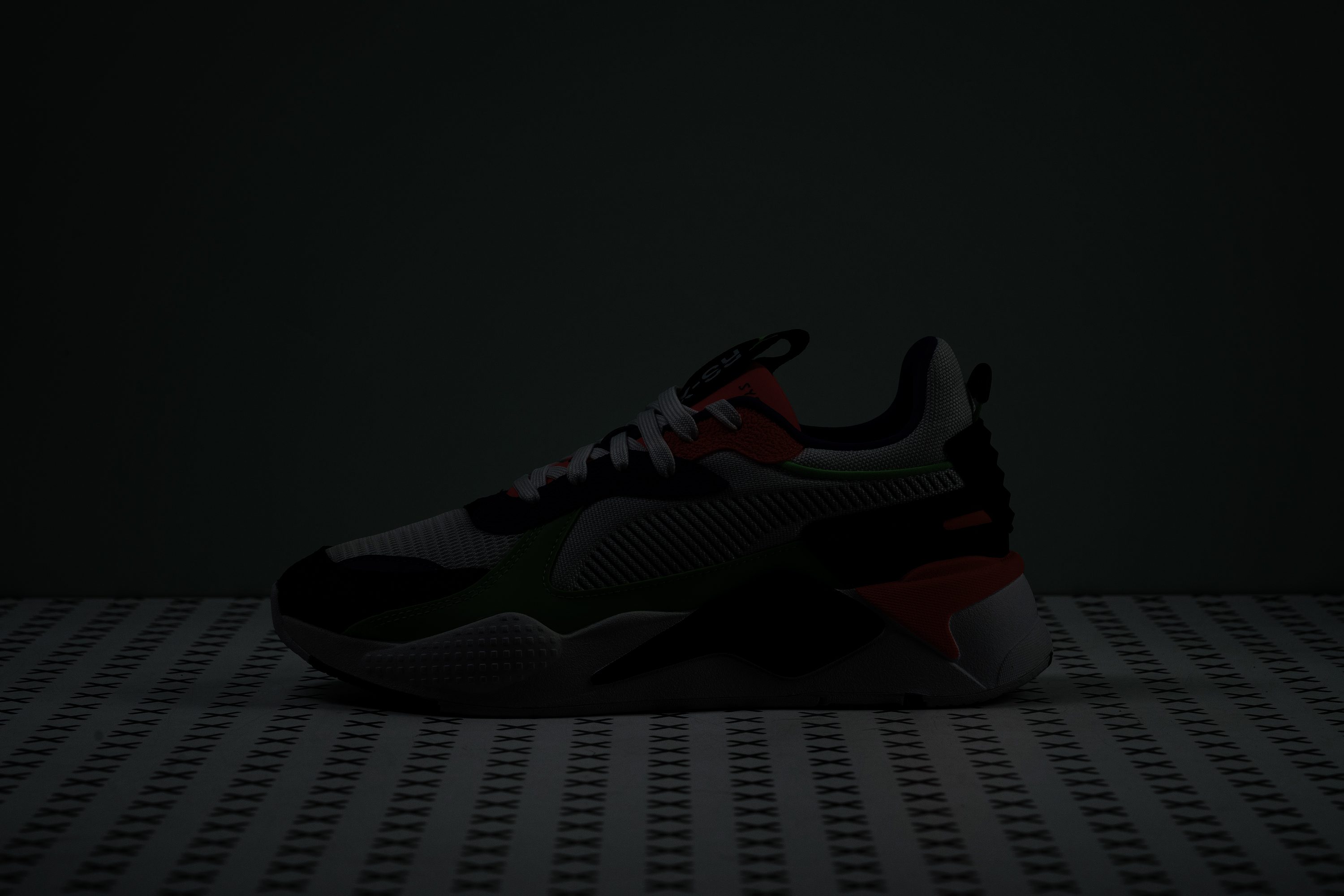
| RS-X | No |
Tongue padding
Actually, the tongue is pretty generously padded on this PUMA shoe. With our caliper showing 11.1 mm, it turns out to be almost twice as thick as the average.

| RS-X | 11.1 mm |
| Average | 9.6 mm |
Tongue: gusset type
The tongue has no gussets on the sides but this never caused any shifting. We found it to be thick and wide enough to remain in place.
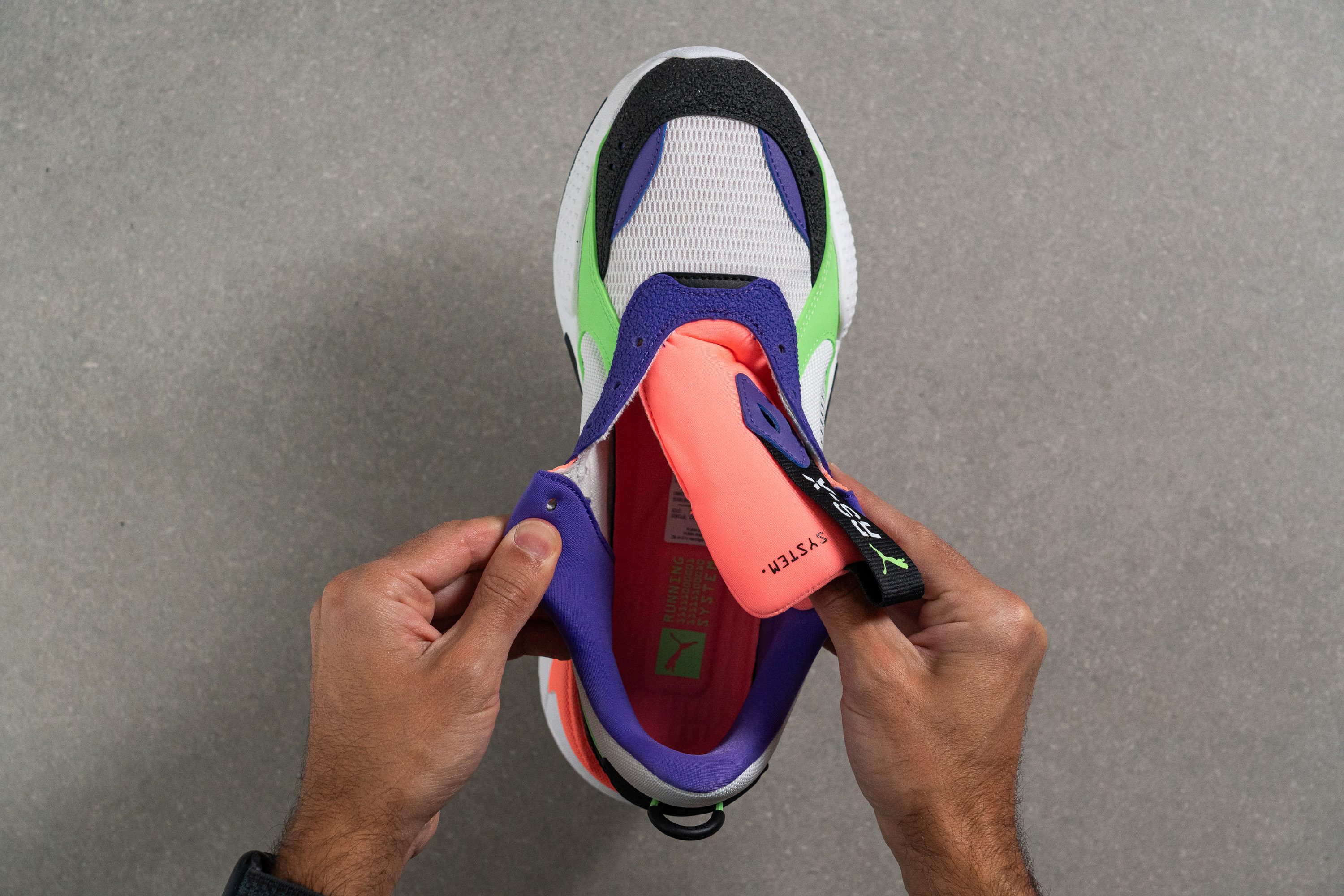
| RS-X | None |
Heel tab
There are two finger loops on the PUMA RS-X: one on the tongue and one on the heel counter. Both are very well integrated into the shoe's overall design and don't feel out of place at all.
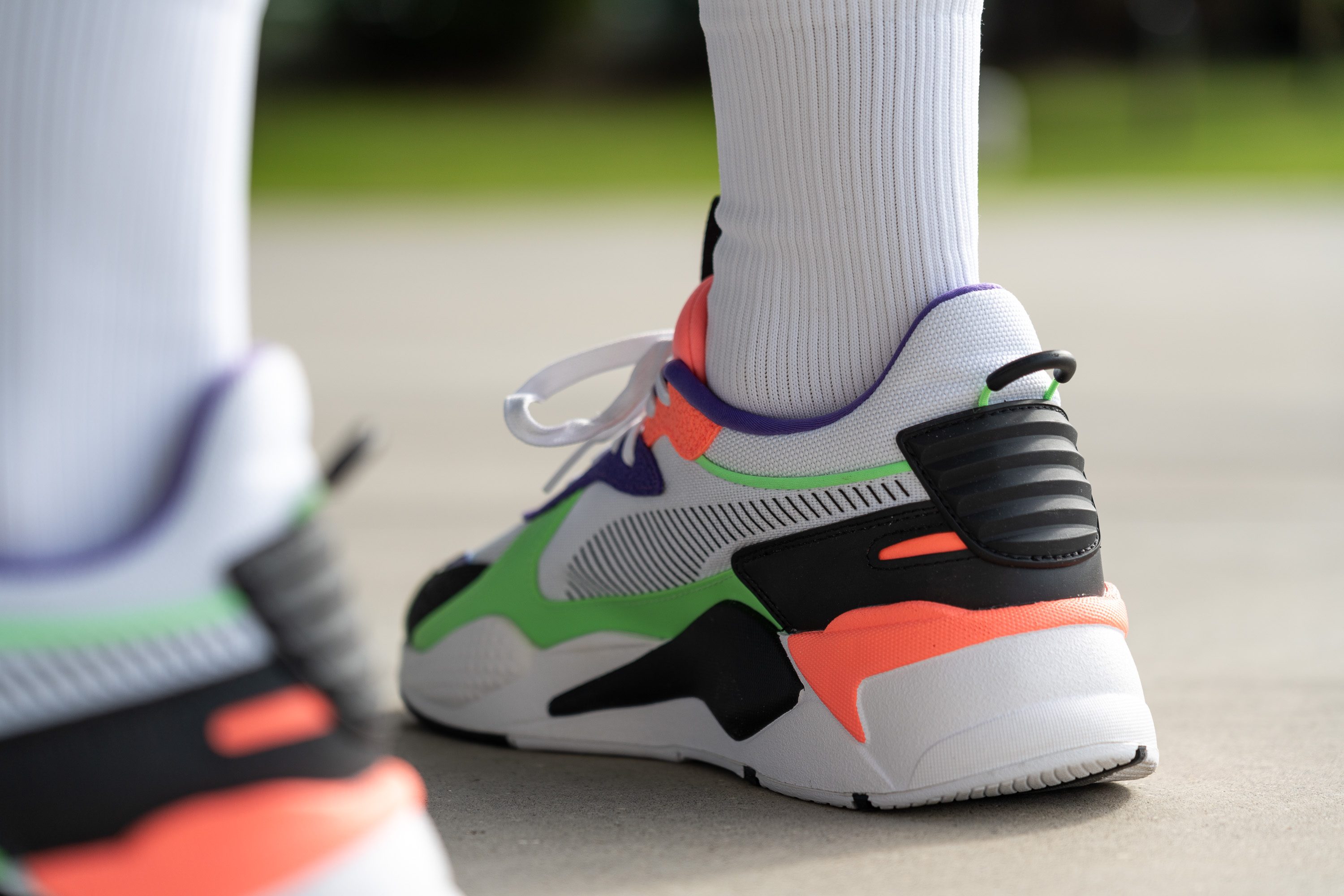
We found them pretty handy for slipping into the sneaker as well as adjusting the tongue on the go.
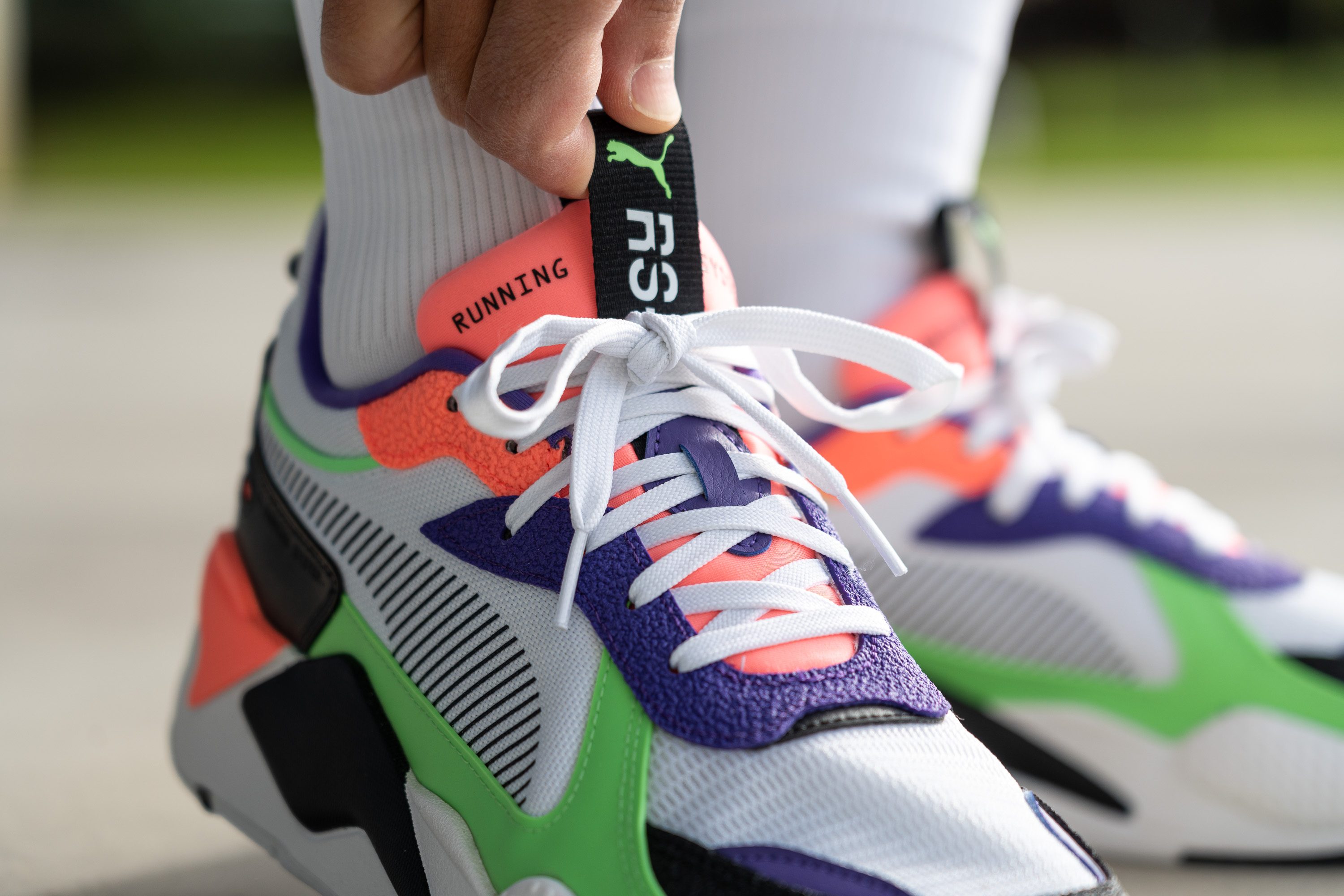
| RS-X | Finger loop |
Background
The first model to carry the PUMA RS cushioning technology was the RS 100, which was released in 1986.
Following in the footsteps of the RS100 was the RS-Computer Chip. It was the first shoe to have a built-in computer chip at the heel that could gather the wearer’s running distance over a period of time. It, too, calculated the caloric cost of running (basically, today’s Fitbit).
In early 2018, PUMA revived the RS cushioning technology with the launch of the reawakened RS-0, along with the modernized versions of the PUMA S-100 and PUMA RS-350.
To continue paying homage to the revolutionary technology, PUMA dropped the RS-X series in late 2018. It's a natural fit for PUMA’s Futro marketing campaign—a selection of future and retro sneakers.
